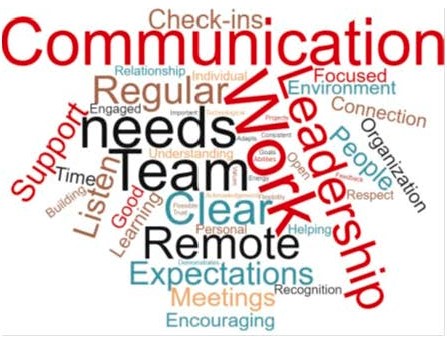Authors: Bruce Griffiths M.S., Deborah Pettry Ph.D., and Michael Slatoff M.A.
EXECUTIVE SUMMARY
Our abrupt shift in 2020 to remote work seems likely to stay to some degree for countless individuals. This has come with personal and social costs for many on remote teams. This raises the questions: What are the differences, if any, in what remote teams need from their leaders? How does/should leadership change in a remote environment?
To get at these questions, in December 2020 – February 2021, we conducted a survey to compare current perceptions of required leadership competency in remote settings with our 20+ years of competency validation research (in almost exclusively face-to-face settings). We surveyed a variety of remote team members from various organization levels, asking them to think about their experiences being led by others remotely. We asked them to rate how essential 41 competencies are for remote leadership and to comment on current leadership needs and mistakes. (See Appendix for complete listing of competencies.)
While the complete list of 41 essential leadership competencies didn’t change per se, their inflection certainly did. In an initial comparison of the top 10 competencies that were deemed essential in face-to-face settings, there were dramatic shifts for remote settings. Communicativeness jumped to most important, and added to this top 10 for remote leadership were Active Listening, Relationship Building, Team Management, and Initiative. These last four replaced Problem Solving, High Standards, Self-Objectivity, and Talent Development. In short, the message is “communicate with me and pay attention to me.”
This document briefly summarizes the key research results and recommendations that remote leaders can implement immediately. Future publications will go into greater depth with both the results and organizational recommendations.
THE NEED FOR RESEARCH
The world around us is increasingly uncertain, unstable, and ambiguous. It seems unlikely that our workplace will ever return to our old normal. Chances are that remote work is here to stay. To underscore the permanence of this change to remote, New York Times columnist Thomas Friedman recently noted, “More people, in more places, can now connect, compete, and collaborate in more ways for less money than ever before.”
This abrupt shift to remote work has come at a social cost. The dictionary definition of remote includes the synonyms “secluded,” “removed,” and “isolated.” All these terms have negative interpersonal implications. To underline this point, measures of stress, mental/physical health, and alcohol/drug consumption have all risen during isolation. After over a year of quarantine, we all really do need a hug.
So, it seems we will continue to serve, and occasionally suffer, on remote teams under leaders we only see in two dimensions. This poses questions for those of us in the leadership business – What are the differences, if any, in what remote teams need from their leaders? How does/should leadership change in a remote environment?
This new reality sparked our current inquiry into leadership in a remote setting. We started with a literature review, and then conducted a survey to compare our 20+ years of competency validation research (in almost exclusively face-to-face settings) with current perceptions of required competency in a remote setting. We surveyed a wide variety of remote team members from various organization levels, asking them to think about their experiences being led by others remotely. We asked them to identify essential competencies for their remote leaders, and to comment on current leadership needs and mistakes.
LITERATURE REVIEW FINDINGS AND SURVEY RESULTS
Our literature review suggested that working on remote teams exacerbates issues of trust, communications, and empathy between leaders and members.
Our survey results confirmed that and more, by revealing a marked increase in emphasis by survey respondents on the communications and socioemotional competencies.
So, as noted above, ratings revealed a clear shift in how essential certain leadership competencies were in remote settings. In an initial comparison of the top 10 competencies needed in face-to-face versus remote, there were dramatic shifts. Communicativeness jumped to most important, and added to this top 10 were Active Listening, Relationship Building, Team Management, and Initiative, replacing Problem Solving, High Standards, Self-Objectivity, and Talent Development.
As you can see in the tables, Communicativeness didn’t just jump to the first spot; it was unanimously seen as essential in their remote leaders by all respondents. Across hundreds of similar surveys this is a highly unusual result. It clearly signals that remote team members greatly need clear and regular two-way communications across every channel available. This includes exchanges that are not just leader to team, but also leader to individual team members, and team member to team member.
WRITTEN COMMENTS
We also asked our respondents three open ended written questions:
- As a team member working remotely what are the most important behaviors you need from your team leader to help you feel satisfied (truly engaged) in your work?
- What is the most common mistake you see remote leaders make in leading their teams?
- What is the one piece of advice you’d give remote leaders?
Analysis of written responses provided more specific detail plus remedies to help remote leaders. As can be seen from a word cloud analysis of our first question, over 50% of respondents reported need for more, and better, two-way communications, both team AND personal.
This was the headline across all three questions: “Communicate with me and pay attention to me.”
WHAT CHANGES ARE NEEDED?
It is obvious we need a shift in application of competencies to hiring, promoting, developing, and managing managers of remote team members. Selection systems, performance appraisals, succession management, and leadership development all need to be adjusted to reflect a new competency inflection in the remote workplace.
More immediately, respondents’ written comments highlighted actions remote team leaders can take now to improve team engagement and productivity:
- Implement a communication plan to reach out to team members as individuals regularly to maintain rapport and explore needs. Ask how they’re doing, both with work and personally, and how you can help.
- Develop a plan to meet and communicate with the team regularly as well. Keep the team agenda fresh, including its connection to organization mission, values, updates, and outcomes. Reinforce current focus, goals, milestones, priorities via clear expectations and feedback. Proactively build your team’s connections and communications with each other as well as with you.
- Actively listen. When meeting with individuals or the team, ignore distractions. As one respondent wrote, “Distraction is the new dismissiveness.” Active listening also means letting people complete what they’re saying and then asking questions that help them communicate and think. It’s shown by remembering what was said.
- Allow flexibility. Let members flex to work around their personal circumstances. Let them choose their 40 hours. Trust them to do their work in their own way, as long as agreed outcomes get met and organization values are honored.
- Be prepared to flex yourself. Leadership is situational, and in addition to reacting appropriately to different levels of follower willingness and ability, be prepared to flex for differences in personality and circumstance in these extremely different times. Some people need greater certainty and assurance, while others need more freedom and trust.
- Offer more rewards, recognition and public kudos. These must be authentic and based on paying attention to what team members are doing and accomplishing, while resisting micromanaging them.
- Use effective meeting planning and management for both formal and informal interactions. Have the right people attending formal meetings and keep them involved. Avoid ZOOM fatigue: three hours is the limit for even active meetings, and that time must include at least one break. Build meaningful personal connections into the meetings and create separate informal social events. (Some respondents emphasized that such social events should be voluntary. However, if someone regularly skips connecting with the team, do check in privately on their reasons and how else they might connect.)
- Provide current remote software tools like ZOOM, SLACK, MS TEAMS, etc. If your shift to remote is permanent, you’ll also need to equip personal home offices with the right hardware, including fast internet, monitors, and video conferencing audio/video.
- Stay positive. Your emotions ARE the team’s emotions. And your message is mostly non-verbal; attend not just to what you say and what you do but also how you communicate. One respondent summarized this as, “The team leader needs to be positive and encouraging to create a productive learning environment that keeps everyone motivated.”
- Take care of yourself. Model balance. Avoid emails and other communications at night and weekends. Avoid telegraphing need for 24/7 connections. Take 15-30-minute breaks throughout the day. Have a life beyond work. Being the main team tent pole does require its own support!
IN SUM, lead your team. Leadership is about relationships. And that means empathy, sympathy, active listening, and personal interest in the well-being of each team member.
FINALLY
Our situation is of course fluid. And already, as we see light at the end of the pandemic tunnel, articles are appearing to help workers with reentry back to physical office space (Do I need to be vaccinated? Do I need to wear a mask? What about physical distancing?). But for a very large percentage of the world’s workforce we are not going back to work, we wake up at work. And that change has some profound implications in terms of how we’re led.
To discuss this report or to learn how we can provide your organization with this same survey, targeted 360° assessments, competency modeling, leadership development, executive coaching, and talent management systems, contact: Deborah Pettry at deb@learningzenith.com or Bruce Griffiths at bgriffiths@orgsysint.com



